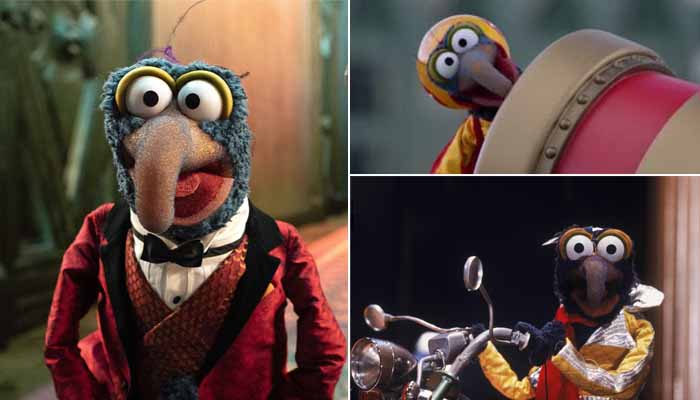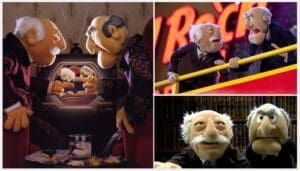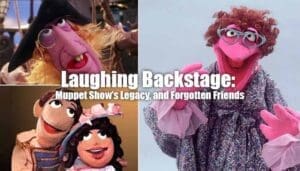There was always a special kind of buzz in the air at the Muppet Theater just before Kermit the Frog, with a sigh that was equal parts resignation and affection, announced the next act: “And now… Gonzo the Great!” What followed was rarely predictable, almost never technically successful, but always pure, unadulterated Gonzo. He wasn’t just another Muppet; he was a force of nature, a purple-furred, hook-nosed enigma who elevated bizarre failure to a high art form, leaving audiences bewildered, amused, and strangely impressed.
Meet the Muppet Show’s Resident Daredevil Artiste
First, let’s address the elephant… or chicken… or whatever in the room. Who, or perhaps more accurately, what is Gonzo? Visually, he’s unforgettable: that distinctive purple-blue fur, the tuft of feathers atop his head, those expressive bug-eyes, and of course, the long, elegantly curved proboscis often referred to as a beak or nose. But his species? That’s one of the Muppets’ most enduring running gags. He debuted as a “Cigar Box Frackle” in The Great Santa Claus Switch , was later revealed to be an alien in Muppets from Space (an offer to rejoin his people he ultimately declined) , and has often been vaguely associated with avian creatures, though not quite a bird. In The Great Muppet Caper, his travel crate is simply labeled “Whatever”. Gonzo himself embraces this ambiguity, identifying as a “whatever”.
This lack of easy classification seems deeply connected to his unique role on The Muppet Show. While Kermit hosted, Fozzie told jokes (or tried to), and Miss Piggy chased stardom (and frogs), Gonzo carved out his own niche as the resident performance artist, stunt double, and daredevil. He wasn’t just performing; he was The Great Gonzo, an artiste with a vision as unique and unclassifiable as his appearance. It’s almost as if, lacking a simple label like “frog” or “bear,” Gonzo chose to define himself through action – specifically, through increasingly bizarre and attention-grabbing stunts. His performances became his identity, a way to shout “Here I am!” in a world that couldn’t quite figure out what he was.
The Gonzo Philosophy: Embracing the Bizarre, Befriending Failure
So, what exactly constituted “Gonzo Art”? It certainly wasn’t conventional. His acts were less about simple entertainment or straightforward daredevilry and more about the concept. Gonzo aimed for the avant-garde, often juxtaposing mundane or perilous actions with high culture, particularly classical music or literary references. Think of his most famous (or infamous) declaration: “Tonight, ladies and gentlemen, I will eat this rubber tire to the music of The Flight of the Bumblebee…music, maestro!”. Or his plan to demolish a vintage automobile with a sledgehammer, accompanied by Verdi’s “Anvil Chorus,” before consuming the crankcase “acappella”. This wasn’t just silliness; it was performance art with a capital, albeit crooked, ‘A’. He genuinely considered his often terrible acts to be artistic statements.
Crucially, success, in the traditional sense, was rarely the objective, and even less frequently the outcome. Gonzo’s peculiar brand of greatness often resided in the sheer audacity of the attempt, the inherent absurdity of the concept, and his unwavering, zany enthusiasm even when things went spectacularly wrong. Whether he was sinking into a vat of oatmeal , being blasted offstage by a cannonball , or crashing his motorcycle yet again , Gonzo would typically brush himself off (sometimes literally scraping goo off) and maintain his artistic dignity, often questioning the audience’s ability to appreciate true art.
This embrace of chaos might stem from his character’s origins. Dave Goelz, Gonzo’s legendary performer, initially played him as having low self-esteem. Later, with Jim Henson’s blessing, Gonzo evolved to possess a “zany, bombastic appreciation for life”. Perhaps those outrageous stunts, demanding attention and defying expectations, were his way of projecting confidence, turning potential vulnerability into performance. The frequent failures weren’t necessarily setbacks; they became part of the spectacle. The art wasn’t just in the perfect execution (which seldom happened), but in the bold attempt, the chaotic reality, and Gonzo’s resilient, often defiant, reaction. He subverted the idea of a polished stage act, making the risk, the mess, and the recovery integral parts of the performance itself.
Curtain Up! Gonzo’s Greatest Hits (and Misses)

Over the five seasons of The Muppet Show, Gonzo unleashed a torrent of bizarre creativity upon the stage. While every act was memorable in its own way, some stand out as particularly emblematic of his unique genius.
1. The Edible Ensemble: Eating a Rubber Tire to “Flight of the Bumblebee”
This is it. The quintessential Gonzo stunt, the one often cited by fans and even referenced by the Muppets themselves. Kermit would introduce him, Gonzo would stride out confidently, announce his intention to consume vulcanized rubber accompanied by Rimsky-Korsakov’s frantic masterpiece, and then… he’d actually do it. The sheer physical impossibility combined with the high-speed musical backdrop created a moment of pure, surreal Muppet magic. The typical reaction from the balcony, however, was less awe and more boredom. “Looks like it’s another wipe out for Gonzo,” Statler might quip. Gonzo’s response? A defiant shrug and a muttered, “Ah yos, what do they know about art?”. It perfectly captured his artistic philosophy: conceptually bizarre, physically questionable, culturally incongruous, and performed with absolute seriousness in the face of audience indifference.
2. Catching a Cannonball (with his bare hand!)
Dialing up the danger, Gonzo decided to test his reflexes against basic physics. Assisted by the Muppets’ resident pyrotechnics expert, the gleefully manic Crazy Harry, Gonzo announced he would catch a cannonball fired from a muzzle-loading cannon using only his bare hand. After requesting complete silence for concentration (a request rarely honored in the Muppet Theater), Harry lit the fuse. The resulting explosion sent Gonzo flying clean off the stage. Yet, amidst the smoke and debris, Kermit pointed out that, technically, Gonzo had caught the cannonball. Statler and Waldorf’s post-mortem was characteristically dry: “I’ve seen my share of cannonball catching acts, but that had something different.” “What was that?” “A survivor”. This act showcased Gonzo’s fearless daredevil side, the hilarious potential for Muppet physical comedy, and the delightfully unhinged contributions of characters like Crazy Harry.
3. Breakfast of Champions: Tap Dancing in Oatmeal
Some Gonzo stunts were less about danger and more about sheer, unadulterated absurdity. Case in point: his plan to perform a sophisticated song-and-dance number, specifically singing “Top Hat,” while tap-dancing inside a large, steaming vat of oatmeal. The visual alone was priceless. He began his routine, “I’m putting on my top hat, tying up my white tie, dusting off my…” before promptly sinking beneath the surface of the viscous porridge. Kermit’s stage-side panic (“Wait! He’s sinking into the oatmeal!”) and attempts to rally a rescue (“Don’t worry, don’t worry, we got spoons and milk and brown sugar!”) were met with the usual cynicism from the balcony: “We’re going to eat our way through to him?” “That’s how they get all their acts. Scraping the bottom…”. A perfect illustration of an ambitious artistic concept colliding messily with reality, resulting in peak Muppet chaos.
4. Motorcycle Mayhem: The Ramp Jumps
A recurring motif in Gonzo’s repertoire involved his trusty motorcycle and a ramp. His goal was often to launch himself across the stage, frequently aiming for the balcony box occupied by Statler and Waldorf. In a display of questionable concern for their safety (or perhaps just to ensure they witnessed his genius), Gonzo would sometimes take the precaution of chaining the two elderly hecklers to their chairs before attempting the jump. The outcomes were predictably disastrous, usually involving crashes, collapsing scenery, or the motorcycle simply rolling away unattended after a failed launch. Statler and Waldorf, naturally, took it in stride, observing Gonzo’s multiple attempts with comments like, “We’re not afraid. We know Gonzo.” “If at first you don’t succeed… fail fail again”. These stunts highlighted Gonzo’s unwavering persistence and his uniquely antagonistic, yet symbiotic, relationship with his harshest critics.
5. Automotive Art: Demolishing a Car to the “Anvil Chorus”
Another high point (or low point, depending on your perspective) in Gonzo’s avant-garde phase involved a vintage automobile, a sledgehammer, and Giuseppe Verdi. His plan: demolish the car piece by piece, accompanied by the stirring sounds of the “Anvil Chorus” from the opera Il Trovatore, after which he intended to eat the crankcase “acappella”. He described it as digging deep into his “limitless repertoire” for an act of profound artistic merit. While the full destruction wasn’t always shown, the setup itself—Gonzo, tool in hand, facing down a jalopy while invoking high opera—was a masterclass in conceptual absurdity. It perfectly demonstrated his commitment to blending high art pretensions with low-brow destruction, treating the entire spectacle as a serious artistic endeavor.
Honorable Mentions: The list goes on! Who could forget Gonzo attempting to wrestle a blindfolded brick (specifically requesting a “welter weight brick”)? Or playing “Eine Kleine Nachtmusik” on the bagpipes while precariously balanced atop a flagpole, only to have an industrious beaver chew through the base? Or balancing a pole on his head topped with a great white shark swimming in a bucket of finger paint? Or hypnotizing chickens? Or performing flamenco with Yolanda the Dancing Cheese? The variety was endless, the common thread being Gonzo’s unwavering commitment to his uniquely peculiar vision.
Gonzo’s Gallery of Grandeur (and Goofs)
| Stunt Name | Artistic Medium/Concept | Notable Outcome | Quintessential Gonzo Element |
|---|---|---|---|
| Tire Eating | Consumption Art/Musical Juxtaposition | Success (but boring) | Absurdity & Defiance |
| Cannonball Catch | Daredevilry/Physics Defiance | Caught (barely survived) | Sheer Danger & Resilience |
| Oatmeal Tap Dance | Performance Art/Culinary Absurdity | Sank immediately | Visual Gag & Embracing Mess |
| Motorcycle Jump | Stunt Show/Heckler Engagement | Crashed repeatedly | Persistence & Antagonism |
| Car Demolition | Destruction Art/Operatic Interpretation | Interrupted/Conceptual | High Art Pretension & Destruction |
Beyond the Mayhem: The Muppet Who Loved a Chicken
But Gonzo wasn’t just about the chaotic stunts and artistic pronouncements. Beneath the daredevil exterior beat the heart of… well, whatever he is. He displayed a surprising capacity for tenderness, most notably through his long-standing and deeply devoted romance with Camilla the Chicken. He first officially courted her in a 1979 episode and their relationship became a sweet, grounding counterpoint to his wild stage antics. This relationship added another layer to his character, proving that even a performance artist obsessed with eating tires could find love.
Over time, Gonzo evolved from a minor figure in the early days of The Muppet Show to one of the absolute core members of the Muppet troupe. He starred in films, memorably playing Charles Dickens (alongside his pal Rizzo the Rat) in The Muppet Christmas Carol , and even enjoyed post-Muppet Show success as a powerful plumbing magnate in The Muppets (a nod to his pre-show plumbing career mentioned in The Muppet Movie).
Interestingly, while his stunts often seemed isolating in their sheer weirdness, they paradoxically served to connect him more deeply with the rest of the Muppet family. Think about it: Kermit’s exasperated but ultimately supportive introductions , Scooter’s attempts to manage his career (briefly) , the Electric Mayhem providing musical backing for his madness, Fozzie’s occasional concern, Crazy Harry’s eager assistance , and even Statler and Waldorf’s relentless heckling. All these interactions, prompted by his acts, demonstrated his integral place within the Muppet community. They expected his weirdness; it was part of the fabric of the show. His stunts became a unique form of communication, a way he interacted with and solidified his role among the friends who became his chosen family, complementing the emotional anchor provided by his relationship with Camilla.
Long Live the Great Gonzo!
Gonzo the Great’s contribution to The Muppet Show was utterly unique. He wasn’t just the weird one; he was a fuzzy, blue (or purple-blue) embodiment of fearless self-expression, boundless artistic ambition (however misguided), and the glorious, liberating absurdity of attempting something completely ridiculous simply because one can. He pushed the boundaries of Muppet performance, blending high-concept art with low-brow slapstick, danger with delight.
Why do we still cherish those moments of magnificent failure and occasional, baffling success? It’s Gonzo’s heart, his unwavering belief in the importance of his “art,” no matter how many times it ended in a heap, a splash, or confused silence. It’s the sheer, unadulterated joy he found in being unapologetically himself – a “whatever” who dared to be great. So, let’s raise a metaphorical rubber tire, or perhaps a spoon full of oatmeal, to Gonzo the Great – may his artistic spirit continue to inspire glorious weirdness for generations to come. After all, even after being blasted across the stage, he still held onto that cannonball. That’s commitment. That’s art. That’s Gonzo.




